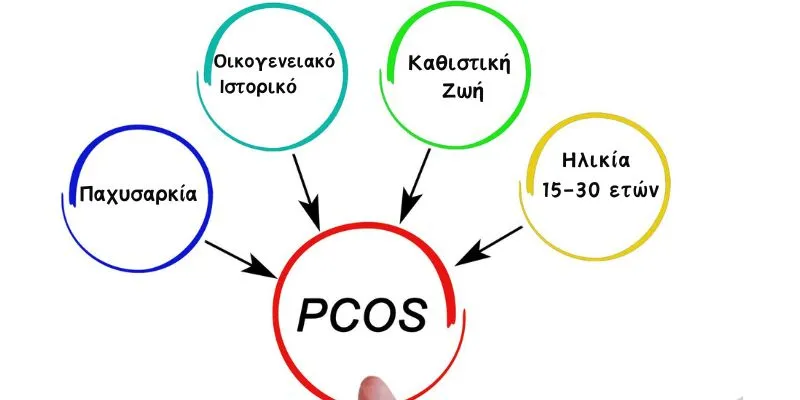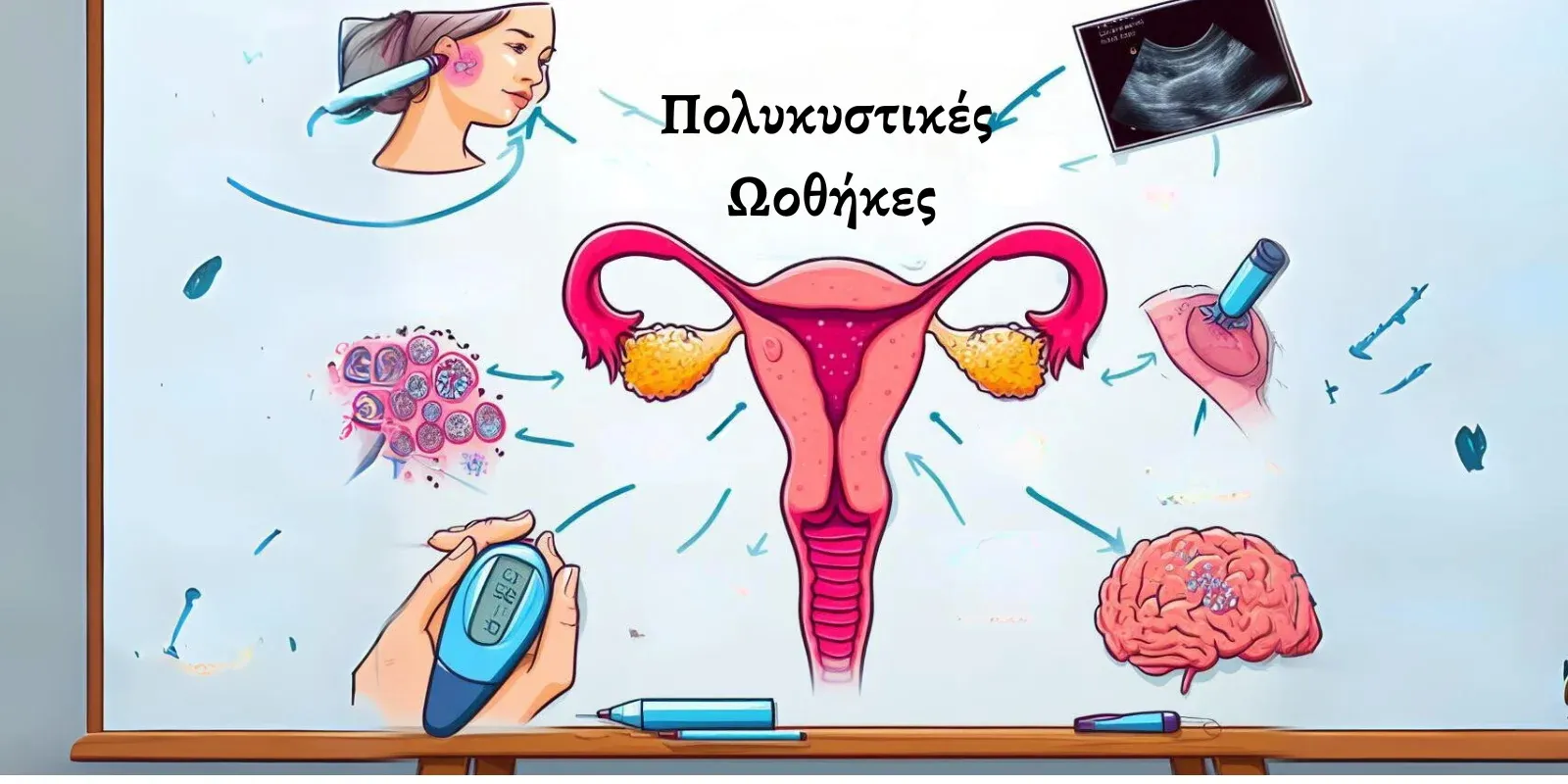Polycystic Ovary Syndrome (PCOS) is a common hormonal disorder affecting approximately 10% of women of reproductive age. It is characterized by irregular periods, increased androgens, obesity, and fertility issues.
The exact causes of polycystic ovary syndrome are unknown; however, it is believed to be a combination of both genetic-hereditary and environmental factors. Insulin metabolism and, more specifically, insulin resistance, seem to play a dominant role in the development of the syndrome.
What makes polycystic ovary syndrome unique?
One of the unique features of polycystic ovary syndrome is that it can manifest differently in each individual. Some women may experience very severe symptoms, while others may have milder or no discomfort at all. This makes treatment for polycystic ovaries more difficult, as a one-size-fits-all approach is not effective for all women.
In this article, we will analyze the various symptoms, diagnoses, and available treatments for polycystic ovaries. By learning more about this condition, we can empower women to take control of their health into their own hands.
What are the symptoms of polycystic ovaries?
Although it may not be immediately apparent, polycystic ovary syndrome can have a significant impact on a woman's overall health and well-being.
Here are just some of the points and symptoms you may face if you have polycystic ovaries:
- Period irregularities:
If you have polycystic ovaries, you may find that your periods often exceed 35 days or are absent or are very heavy when they do occur. - Increased facial and body hair:
One of the most visible signs in women with polycystic ovaries is excessive hair growth on the face, chest, and back. - Acne:
Polycystic ovary syndrome can cause acne or worsen existing acne on the face or the rest of the body. - Difficulty maintaining weight:
Weight gain, especially around the waist, and difficulty losing weight are common features in many women with polycystic ovaries. Obesity is common but not necessary in these patients. - Fertility issues:
Polycystic ovary syndrome can make it more difficult to achieve pregnancy due to irregular ovulation in women of reproductive age. More on this topic here. - Hair thinning:
Some women with polycystic ovaries may notice that their hair is thinning due to increased levels of androgens. - Dark skin patches:
Polycystic ovary syndrome can cause the appearance of dark skin patches, called acanthosis nigricans. They often appear in the neck and armpit area and seem to be related to blood insulin levels. - Emotional aspects of polycystic ovaries:
We analyze the psychological implications of the syndrome in detail here.

How is Polycystic Ovary Syndrome Diagnosed?
Very often, women with typical symptoms of the syndrome, as well as others with less typical symptoms, go undiagnosed for many years. For diagnosis, it is crucial to take a detailed history, blood tests for basic hormone levels, and an ultrasound, all of which will be evaluated by a qualified gynecologist specialized in polycystic ovaries.
The diagnosis for polycystic ovaries is made if at least 2 of the following 3 criteria are met:
1. Menstrual Irregularities
Menstrual cycle disorders in women with PCOS are very common. Thus, the periods of these women are usually rare (more than 35 days) and heavier.
2. Elevated Androgen Levels
Elevated levels of hormones, such as testosterone, are observed. These either appear clinically in a woman (for example, with intense hair growth) or can be confirmed by measuring hormone levels in the blood.
3. Multiple Small Cysts in the Ovaries on Ultrasound or High AMH Levels (anti-mullerian hormone)
As the name of the syndrome suggests, cysts appear in the ovaries, specifically on their periphery, up to 10 mm in size, which contain immature eggs. The arrangement of these cysts makes them look like a 'pearl necklace' on ultrasound. The latest guidelines suggest checking AMH levels as an alternative diagnostic criterion to ultrasound findings.
It is very important, although unfortunately not always applied, to rule out other rarer diseases before diagnosing polycystic ovary syndrome. There are diseases that often mimic the symptoms of polycystic ovaries, such as congenital adrenal hyperplasia, thyroid diseases, and tumors that produce androgens.
Diagnostic Criteria for Polycystic Ovary Syndrome (PCOS)
| Criterion | Description |
|---|---|
| Menstrual irregularities | Rare (over 35 days) or absent periods |
| Increased androgen levels | Increased levels of testosterone and/or other androgens, either clinically evident (e.g., excessive hair growth) or in blood hormone tests |
| Multiple small cysts or high AMH levels | Polycystic ovaries on ultrasound or increased AMH |
Note: It is important to rule out other rarer diseases before diagnosis
Is there treatment for polycystic ovaries? What are the treatment options?
The treatment of polycystic ovaries depends on the symptoms and goals of each woman individually. It focuses on controlling the most bothersome and dominant symptoms and improving the individual's overall quality of life.
Lifestyle Changes. Exercise and Diet:
The alpha and omega in the treatment of polycystic ovaries, but also the most difficult, is lifestyle change. Making healthy choices, such as a balanced diet and regular exercise, can help more than anything else in regulating the cycle, improving fertility, and reducing the risk of other health problems related to polycystic ovary syndrome. It is important to try to maintain a normal weight, as excessive body fat can exacerbate the symptoms of the syndrome. A low glycemic index diet, which includes foods that are absorbed slowly and cause a slower increase in blood insulin, can be particularly beneficial. Finally, exercise, even of mild intensity, can improve many of the symptoms in women with polycystic ovary syndrome. For further information in the related article here.
Pharmacological treatment:
Various types of drugs can help manage specific symptoms. Contraceptive pills can regulate the period and reduce androgen production. Drugs like metformin can improve insulin resistance, help regulate the cycle, weight loss, and reduce the risk of type 2 diabetes. Antiandrogens, on the other hand, can reduce excessive hair growth and acne by reducing the androgens produced by the ovaries.
Assisted Reproduction Techniques:
For women suffering from infertility and wishing to have a pregnancy, assisted reproduction techniques are an option with very good results for women with polycystic ovaries.
How can a good gynecologist help in treating polycystic ovaries?
As a gynecologist with a special interest in polycystic ovaries, I have seen firsthand the significant impact this condition can have on a woman's physical and mental health. However, with the right diagnosis and treatment, effective management of polycystic ovaries and improvement of most symptoms is possible.
Lifestyle changes, such as a healthy diet, weight regulation, and regular exercise, as well as drugs and alternative treatments, can play a significant role in improving the lives of women with polycystic ovaries. It is important for any patient experiencing the symptoms of the syndrome to seek medical help and receive personalized treatment and medication.
We can work together for better management of this condition and improve your quality of life.
Sources
https://www.eshre.eu/Guidelines-and-Legal/Guidelines/Polycystic-Ovary-Syndrome
Συχνές Ερωτήσεις (FAQs) για τις Πολυκυστικές Ωοθήκες
1. Πώς μπορώ να καταλάβω αν έχω πολυκυστικές ωοθήκες;
2. Τι εξετάσεις πρέπει να κάνω για να δω αν έχω πολυκυστικές ωοθήκες;
3. Ποιες είναι οι επιλογές θεραπείας για τις πολυκυστικές ωοθήκες;
4. Μπορούν οι πολυκυστικές ωοθήκες να επηρεάσουν τη γονιμότητα;
5. Τι κινδύνους έχουν οι πολυκυστικές ωοθήκες μακροπρόθεσμα;
6. Πώς φεύγουν οι πολυκυστικές ωοθήκες;
7. Μπορεί να θεραπευτεί το σύνδρομο πολυκυστικών ωοθηκών;
8. Υπάρχει πιθανότητα εγκυμοσύνης αν έχω πολυκυστικές ωοθήκες;
9. Είναι απαραίτητο να πάρω αντισυλληπτικά αν έχω πολυκυστικές ωοθήκες;
Πηγές
Mohan A, Haider R, Fakhor H, et al. Vitamin D and polycystic ovary syndrome (PCOS): a review. Ann Med Surg (Lond). 2023;85(7):3506-3511. Published 2023 Jun 5. doi:10.1097/MS9.0000000000000879
Akre, S., Sharma, K., Chakole, S., & Wanjari, M. B. (2022). Recent Advances in the Management of Polycystic Ovary Syndrome: A Review Article. Cureus, 14(8), e27689. https://doi.org/10.7759/cureus.27689


